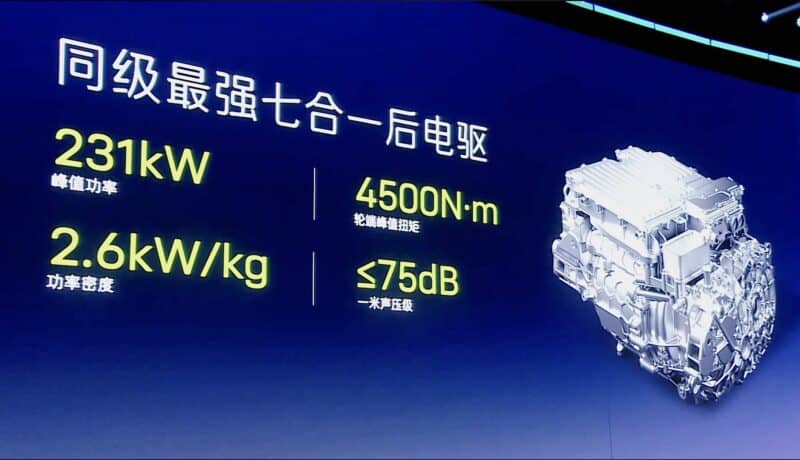Avatr’s Kunlun range extender technology tackles the problems of power attenuation and battery charging
On August 21, Avatr unveiled its new Kunlun range-extending technology. Avatr will first use the new range extender system in the forthcoming Avatr 07 SUV, and later, the system will find its way into the Avatr 11 and 12 models.
Key claims for the new system are the lack of power attenuation after the battery reaches a low state of charge and that the battery supports fast charging. Ultimately, Avatr claims that the EREV system feels more like an all-electric car, something that is not the case with other EREV systems.
The actual capacity of the engine being used as a range extender was not announced at the launch of the Kunlun technology. However, it should be the JL469ZQ1 1.5T engine, which was previously announced in the MIIT listing of the Avatr 07. Sourced from Changan it has a peak power of 115 kW. What is known is that the unit used in the Kunlun system has a thermal efficiency of 44.39% and a compression ratio of 15:1. The conversion rate of oil to electricity is 3.63 kWh/l. Avatr has done considerable work on reducing NVH caused by the engine and claims that the operating noise is less than 75 dB. Using active control technology, the car can place the engine pistons in the best position with the lowest starting cylinder pressure every time the engine is turned off. Engine starting cylinder pressure is reduced by 62.5%, and the vibration at startup is reduced by 90%.
The engine can operate at ambient temperatures between -35°C and 65 °C. Furthermore, the power output can be controlled according to road conditions, with factors such as a slope or traffic jams influencing the operation of the engine. In the case of a traffic jam, the car will generate electricity in advance and just use electric power when meeting the traffic congestion.
Power to the rear wheels will come from a 231 kW 7-in-1 electric drive system. Avatr has created a system to try to maximize power from the motor by more accurately measuring temperature. At about 180°C, the permanent magnet on a motor rotor will become permanently demagnetized. Therefore the industry usually limits the power output of the motor once the rotor reaches around 140°C, the problem is it is very difficult to measure the temperature accurately. Usually, this is attempted by measuring the temperature of the cooling oil, but the error rate can be as high as 30°C, meaning that the power of the motor begins reducing at just 110°C.
In the Kunlun system Avatr tries to control the temperature increase while also measuring the temperature more accurately. The system uses more than 30 winding spray holes to shower the system, and the rotor is cooled by magnetic steel helping improve continuous power. Furthermore, the reducer has 12 spray ports with precise and active spray cooling.
To measure the temperature more accurately, sensors are installed in 50 key positions of the motor, and using large model AI, the system can more accurately measure the temperature. What this means is that while an ordinary motor might begin to start limiting power output when the temperature is 110°C, in the case of the Kunlun range extender, this will not start until 132°C. Under testing, the Kunlun system has achieved 25 consecutive acceleration runs up to 100 km/h without the power declining, which Avatr claims Is the strongest in the industry.
A typical problem with EREVs is their performance declines when the car is under feed conditions. Avatr says that 07 equipped with the Kunlun system can accelerate from 0- 100 km/h in 4.9 seconds when fully charged and 5.8 seconds under the feed state. This means a difference of 0.9 seconds and an acceleration attenuation of 15.5 %. According to Avatr the competition has a rate of 44 to 45% with for example the Li L6 accelerating in 5.28 seconds under fully charged conditions but 9.55 seconds when using the range extender to feed the battery.

This situation is caused by the battery discharge power decreasing during feeding and not being enough to support the power required for the operation of the motor. To solve this problem Avatr and CATL jointly developed a 39 kWh Shenxing super hybrid battery dedicated to range extension. Peak discharge power is up to 9C at full charge and 7.7C when feeding. It should be noted that although Changan is the largest shareholder (40.99%) of Avatr Technology, CATL is the second largest with a 14.1% share.

Avatr identified another pain point with EREVs and claims that although they are fast to refuel, they are slow to recharge, often taking longer to recharge than an all-electric car with a larger capacity battery. The 39 kWh Shenxing battery being used at launch is a 3C battery, which allows the car to charge from 30 to 80% SOC in 15 minutes. The battery gives the Avatr 07 a 245 km all-electric range and a comprehensive range of 1152 km using the CLTC measurement system.
However, next year, Avatr will launch a 07 equipped with a 52.4 kWh Shenxing 4C super hybrid battery developed by CATL. This battery has a maximum charging rate of 4C and allows a 30 to 80% charge in 10 minutes. It gives the car an electric range of 325 km and a comprehensive range of 1220 km.

The Kunlan system will initially debut in the Avatr 07 and by the end of the year will also appear in the Avatr 11 and 12 models. With many customers opting for range extenders due to range anxiety with all-electric cars the Avatr brand should receive a sales boost.
Sources: Autohome, Fast Technology



